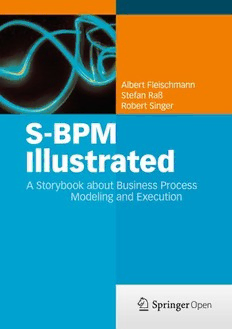Table Of ContentS-BPMIllustrated
AlbertFleischmann
StefanRaß
RobertSinger
S-BPM Illustrated
AStorybookaboutBusinessProcessModeling
andExecution
AlbertFleischmann RobertSinger
Pfaffenhofen,Germany Graz,Austria
StefanRaß
Graz,Austria
ISBN978-3-642-36903-2 ISBN978-3-642-36904-9(eBook)
DOI10.1007/978-3-642-36904-9
LibraryofCongressControlNumber:2013937512
ACMComputingClassification(1998):J.1,H.4,K.6
Springer
OpenAccessThischapterisdistributedunderthetermsoftheCreativeCommonsAttributionNoncommercialLicense,which
permitsanynoncommercialuse,distribution,andreproductioninanymedium,providedtheoriginalauthor(s)andsourceare
credited.
©TheEditor(s)(ifapplicable)andtheAuthor(s)2013.
ThebookispublishedwithopenaccessatSpringerLink.com
AllcommercialrightsarereservedbythePublisher,whetherthewholeorpartofthematerialisconcerned,specificallythe
rightsoftranslation,reprinting,re-useofillustrations,recitation,broadcasting,reproductiononmicrofilmsorinanyotherway,
andstorageindatabanks.Duplicationofthispublicationorpartsthereofispermittedonlyundertheprovisionsofthe
CopyrightLawofthePublisher’slocation,initscurrentversion,andpermissionforcommercialusemustalwaysbe
obtainedfromSpringer.PermissionsforcommercialusemaybeobtainedthroughRightslinkattheCopyrightClearanceCenter.
ViolationsareliabletoprosecutionundertherespectiveCopyrightLaw.
Theuseofgeneraldescriptivenames,registerednames,trademarks,etc.inthispublicationdoesnotimply,evenintheabsence
ofaspecificstatement,thatsuchnamesareexemptfromtherelevantprotectivelawsandregulationsandthereforefreefor
generaluse.
Printedonacid-freepaper.
SpringerispartofSpringerScience+BusinessMedia
www.springer.com
S-BPMstandsfor“subject-orientedbusinessprocessmanagement”andfocuseson
subjects.Subjectsrepresenttheentities(peopleorprogramsetc.)whoareactively
engagedinprocesses.
S-BPMhasbecomeoneofthemostwidelydiscussedapproachesforprocess
professionals.Itspotentialparticularlyliesintheintegrationofadvancedinformation
technologywithorganizationalandmanagerialmethodstofosterandleverage
businessinnovation,operationalexcellenceandintra-andinter-organizational
collaboration.ThusS-BPMcanalsobeunderstoodasstakeholder-orientedandsocial
businessprocessmanagement.
S-BPMasadisciplineischaracterizedbyastraightforwardapproachtowardsthe
analysis,modeling,implementation,executionandmanagementofinteraction
patternswithanexplicitstakeholderfocus.
InstituteofInnovativeProcessManagement,www.i2pm.net,2013.
vii
Preface
Thisbookshowshowsubject-orientedbusinessprocessmanagement(S-BPM)andits
toolscanbeusedinordertosolvecommunicationandsynchronization problemsof
humansand/ormachinesinanorganization.
Thisisahands-onbook.Alltheactivitieswhicharenecessarytoimplementabusi-
nessprocessare shown stepby step. We start with analyzing the problem, continue
withmodelingandvalidatingthecorrespondingprocess,andfinishoffbyembedding
the processinto the organization. The final result is a workflow which executesthe
processwithout requiring any programming. In the first step a very simple process
isimplemented.Thisprocessisextendedandimprovedin“adaptionprojects”,because
additionalproblemshavetobesolved.Thisreflectsrealitywhereprocessesmustalways
bechangedandadaptedtonewrequirements.
Ifyouwanttoexecuteallthestepsbyyourselfyoucandownloadthetoolsuitefrom
the www.i2pm.net website. If you want to get more background information about
S-BPMyoucanfinditinthebook“Subject-OrientedBusinessProcessManagement”
whichisavailableasaSpringerOpenBook.YoucandownloaditfromSpringersweb-
site1forfree.
Therearemanypeopleinthebackgroundwhohelpedintheproductionofthisbook.
Inparticular,theauthorswishtothankMetasonicAGforallowinguseoftheirBPM
suite,UdoKannengiesserforproofreadingthemanuscript(allremainingerrorsarethe
authors),andlastbutnotleastRalfGerstnerofSpringerVerlagforhissupportandco-
operation.
Graz,March2013 AlbertFleischmann
StefanRaß
RobertSinger
1http://link.springer.com/book/10.1007/978-3-642-32392-8/page/1
ix
Contents
1 Introduction................................................................ 1
1.1 BusinessProcessesandBusinessProcessManagement....................... 1
1.2 Taylorism,Fordism,andPost-Fordism......................................... 2
1.3 CommunicationinsteadofCentralControl.................................... 4
2 TheProblem–PartI........................................................ 7
2.1 DoyouKnowthis?.............................................................. 7
2.1.1 AboutCommunication...andotherTroubles..................................... 7
2.1.2 DailyQuarrelintheFactory....................................................... 8
2.1.3 TheSolution? .................................................................... 10
2.2 WhatisS-BPM? ................................................................. 11
2.3 TheWorkshop .................................................................. 14
3 TheSolution–PartI........................................................ 21
3.1 SummaryoftheProblem....................................................... 21
3.2 Solution–StepbyStep∣ScenarioI............................................ 21
3.2.1 CreatingaProject ................................................................ 21
3.2.2 CreatingaProcess................................................................ 22
3.2.3 ModelingtheProcess–SubjectCommunication.................................. 24
3.2.4 ModelingtheProcess–InternalBehavior ......................................... 30
3.2.5 EnactingandExecutingtheProcess............................................... 49
3.3 Accomplishments............................................................... 65
3.4 LessonsLearned................................................................ 65
4 Transition–PartI........................................................... 67
5 TheProblem–PartII....................................................... 69
6 TheSolution–PartII....................................................... 77
6.1 SummaryoftheProblem....................................................... 77
6.2 Solution(StepbyStep)......................................................... 77
6.2.1 CopyingtheProcess.............................................................. 77
6.2.2 AlteringtheProcess .............................................................. 80
6.2.3 AlteringtheInternalBehavior..................................................... 83
6.2.4 ExecutingtheProcess ............................................................ 92
x Contents
6.3 Accomplishments............................................................... 97
6.4 LessonsLearned................................................................ 98
7 Transition–PartII.......................................................... 99
8 TheProblem–PartIII ...................................................... 101
9 TheSolution–PartIII ...................................................... 105
9.1 SummaryoftheProblem....................................................... 105
9.2 Solution(StepbyStep)......................................................... 105
9.2.1 CopyingtheProcess.............................................................. 105
9.2.2 AlteringtheProcess.............................................................. 106
9.2.3 AlteringtheInternalBehavior..................................................... 109
9.2.4 CustomizingtheProcess.......................................................... 118
9.2.5 ExecutingtheProcess ............................................................ 118
9.3 Accomplishments............................................................... 124
9.4 LessonsLearned................................................................ 124
10 Transition–PartIII......................................................... 127
11 TheProblem,theSolutionandtheEnd–FinalPart ..................... 129
12 Troubleshooting ........................................................... 139
TheInstituteofInnovativeProcessManagement ............................... 141
S-BPMONEConferenceSeries..................................................... 143
1
1
Introduction
Subject-orientedBusinessProcessManagement(S-BPM)isdifferentfromcurrentBPM
approaches. InthischapterwewanttoexplainwhatprocessesandBusinessProcess
ManagementareaboutandonwhichhiddenparadigmscurrentBPMapproachesare
based.ThenweshowhowS-BPMisdifferenttomostoftheseapproaches.
1.1 BusinessProcessesandBusinessProcessManagement
Inmoderndays,nosuccessfulcompanywithoutprocessesexists.Largecompaniesmay
evenhavehundredsofdifferentprocesses. Theseprocessescanberemarkablysimple
withonlyoneortwoparticipantsorhighlycomplexwithadozenorevenhundredsof
participants.Processesusethecompany’sresourcestoproduceadesiredoutputthatis
ofvalueforthecompanyoritsstakeholders(i.e.,customers).Thisoutput,forinstance,
canbeaserviceoraproduct(technicalorotherwise).Itisveryimportantforcompanies
tokeeptheirprocessesaseffectiveandefficientaspossible;thisisensuredthroughthe
useofBusinessProcessManagement(BPM).BPMusesmanydifferentmethodsand
toolstoidentify,control,andimproveacompany’sprocesses.
Aprocessisastructureconsistingoflogicallyconnectedtasks,operators,material
expenses,andinformation. Thisincludesachronological,geographical,andquantita-
tivedefinition. Aprocesshasadefinedlaunchevent(input)andresult(output)with
thegoalofproducingsomethingofvalueforcustomers.Thesumofallprocessesisthe
processorganization.1
Processesmustbecontinuouslyadaptedtochangingbusinessenvironments. This
shouldbedoneinastructuredandwell-definedway.Thisactivityiscalledbusinesspro-
cessmanagementwhichis,accordingtoFischermanns2andRogerT.Burlton3,apro-
cess in itself. This process has to be managed and controlled, to ensure continuous
improvementof the organization’s performance (and therefore success). InBusiness
ProcessManagementthefollowingactivitybundleshavetobeexecuted:
4 Analyzeaprocess
4 Modelaprocess
4 Validateaprocess
4 Optimizeaprocess
4 Embedaprocessintotheorganizationalstructure
4 EmbedexistingIT-Solutionsintoaprocess
4 Runandmonitorinstancesofaprocess
1Dr. G.Fischermanns: Praxishandbuch Prozessmanagement, 6. Auflage, Gießen: VerlagDr. Götz
Schmidt2006,p.12
2Dr. G.Fischermanns: Praxishandbuch Prozessmanagement, 6. Auflage, Gießen: VerlagDr. Götz
Schmidt2006,p.26f.
3RogerT.Burlton: BusinessProcessManagement, ProfitingfromProcesses,USA:SamsPublishing
2001
A.Fleischmannetal.,S-BPMIllustrated,DOI10.1007/978-3-642-36904-9_1,©TheAuthor(s)2013
2 Chapter1⋅Introduction
Normallytheseactivitiesarenotstrictlyexecutedinthatorder. Ifdeficienciesare
discoveredinaprocessmodelyoucangobackeithertoanalyzingaprocessormodeling
aprocess.
CurrentBPMapproachesarestillheavilyinfluencedbyScientificManagementpro-
posedbyF.W.Taylor4 andFordismdevelopedbytheFordMotorCompany5. Inthe
followingsectionswewanttoshowthatTaylorismandFordismarestilltheunspoken
paradigmsunderlying“modern”businessprocessmanagement.
1.2 Taylorism,Fordism,andPost-Fordism
Taylor began by analyzing work systematically. He wanted to replace the “rules of
thumb”usedfororganizingworkwithasystematicscientificapproach. Themajoras-
pectsofTaylor’sScientificManagementaredescribedinhisarticle“ThePrinciplesof
ScientificManagement”(seefootnote4):
Undertheoldtypeofmanagementsuccessdependsalmostentirelyupongetting
the“initiative”oftheworkmen,anditisindeedararecaseinwhichthisinitiativeis
reallyattained.Underscientificmanagementthe“initiative”oftheworkmen(that
is,theirhardwork,theirgood-will,andtheiringenuity)isobtainedwithabsolute
uniformityandtoagreaterextentthanispossibleundertheoldsystem;and
inadditiontothisimprovementonthepartofthemen,themanagersassume
newburdens,newduties,andresponsibilitiesneverdreamedofinthepast.
Themanagersassume,forinstance,theburdenofgatheringtogetherallofthe
traditionalknowledgewhichinthepasthasbeenpossessedbytheworkmenand
thenofclassifying,tabulating,andreducingthisknowledgetorules,laws,and
formulaewhichareimmenselyhelpfultotheworkmenindoingtheirdailywork.
Inadditiontodevelopingascienceinthisway,themanagementtakeonthree
othertypesofdutieswhichinvolvenewandheavyburdensforthemselves.These
newdutiesaregroupedunderfourheads:
First.Theydevelopascienceforeachelementofaman’swork,whichreplaces
theoldrule-of-thumbmethod.
Second. Theyscientificallyselectandthentrain,teach,anddevelopthe
workman,whereasinthepasthechosehisownworkandtrainedhimselfasbest
hecould.
Third. Theyheartilycooperatewiththemensoastoensureallofthework
beingdoneinaccordancewiththeprinciplesofthesciencewhichhasbeen
developed.
Fourth. Thereisanalmostequaldivisionoftheworkandtheresponsibility
betweenthemanagementandtheworkmen.Themanagementtakeoverallwork
forwhichtheyarebetterfittedthantheworkmen,whileinthepastalmostallof
theworkandthegreaterpartoftheresponsibilitywerethrownuponthemen.
4Taylor, Frederick Winslow (1911), ThePrinciples ofScientificManagement, NewYork, NY,USA
andLondon,UK:HarperandBrothers,LCCN11010339,OCLC233134.AlsoavailablefromProject
Gutenberg
5Anoverviewandreferences canbefoundathttp://en.wikipedia.org/wiki/Fordism lastaccessJan-
uary2013

